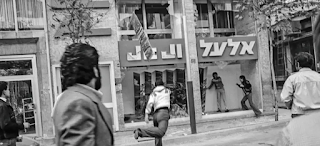
Lior Sternfeld, author of “Between Iran and Zion: Jewish Histories of Twentieth-Century Iran” (Stanford University Press, 2018) is not best pleased with Tehran, the new Israeli Netflix series because it shows a Jew putting family loyalty before loyalty to the Iranian revolution. The downfall of the Shah of Iran, he tells Ofer Aderet of Haaretz, was supported by ‘a great majority’ of Jews. It is true that Jews have always been active in revolutionary movements (the Russian revolution, the FLN in Algeria, etc) but Sternfeld is in danger of exaggerating the support of Jews for change – and whitewashing the oppressive antisemitism of the Islamic revolution. (Sternfeld has form here). The revolution caused untold suffering to Jews, claimed the lives of dozens, dispossessed them of their property and forced the great majority into exile without bothering to establish what their politics were.
Protesters attacking the offices of El Al in 1978
On the eve of the revolution they saw themselves as an integral part of the Iranian nation and identified with the people’s struggle for democracy, independence, freedom and equality. Sternfeld describes how many of them experienced the shah’s tyranny and his dictatorship as Iranians, not only as Jews.
From there the way was short to their integration in diverse political groups and organizations, whose common denominator was their opposition to the shah’s authoritarian monarchic regime.
This was the background to the establishment of the organization of Jewish intellectuals in Iran in 1978, which gave expression to the Jews’ dissatisfaction with the monarchical regime.
The organization immediately started to cooperate with other revolutionary factions, including Muslim activists. “We formed this group in order to show the rest of the people in Iran that we Jews were not woven from a different fabric of society than other Iranians, but that we also supported goals for democracy and freedom,” Said Banayan, one of the organization’s founders, told Sternfeld.
The author sees this as an example that illustrates well that the Jews “stood shoulder to shoulder with their compatriots and placed the national need ahead of the needs of the community.”
Aderet: There is an irony here. It was the shah who drew the minorities, including the Jews, closer to Iranian nationalism, and then they joined the 1979 revolution in order to topple the regime. Accordingly, you title the chapter dealing with this “Unintended Consequences.”
“Correct. The shah’s nationalism project scored a success to the point where the Jews were able to think of themselves first of all as Iranians, and to go into the streets in protest against the situation of the Iranians, and not only to think about relations between the shah and the Jews. The great majority of the Jews were against the continuation of the monarchy and supported the looming revolution.” There were also Jews who participated actively in the fighting, though their exact number is unknown. Some of them did so within the framework of their activity in Iranian professional organizations or in explicitly Jewish organizations.
Others were active in organizations that were almost wholly Muslim and that supported the revolution. One of those organizations was Mujahedin-e Khalq (People’s Mujahedin Organization of Iran). One of the Jewish activists in the organization was Edna Sabet, who was born in 1955 to a Tehran Jewish family from the urban middle class, and many of whose relatives were engineers and industrialists who acquired their education in the United States.
During her years of study at Ariyamehr Technical University in Tehran, Sabet began to become involved in political activity. Subsequently, in the wake of her Muslim husband, she joined the Mujahedin and became a prominent figure in the movement. The members of the movement fought alongside the revolutionaries against the shah’s oppressive regime, but after the revolution they were denied the right to take part in the elections and they opposed the new regime and were persecuted by it.
Among those who suffered that fate was Sabet: She was arrested and executed in 1982, at the age of 27. What was a left-wing Jewish woman doing in an Islamic revolutionary organization in the first place? “Despite her tragic end, her story illustrates another aspect in the complex weave of identities and loyalties that characterized many of those from her generation,” Sternfeld says.

Leave a Reply